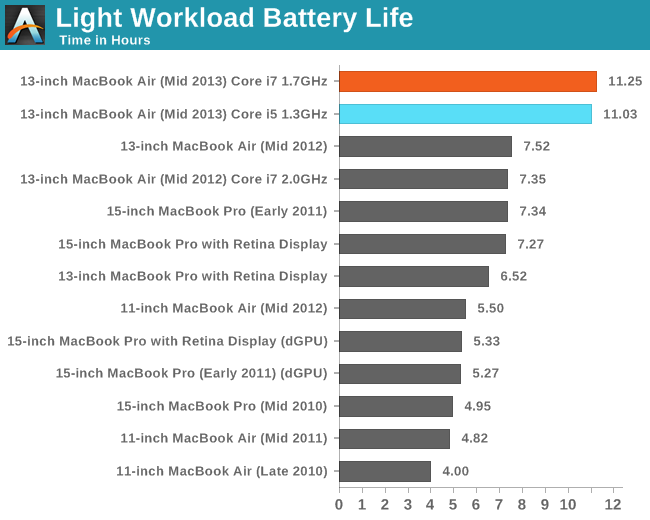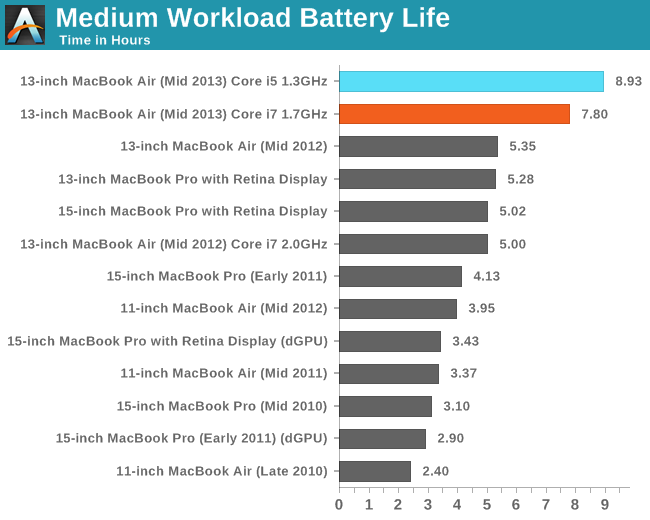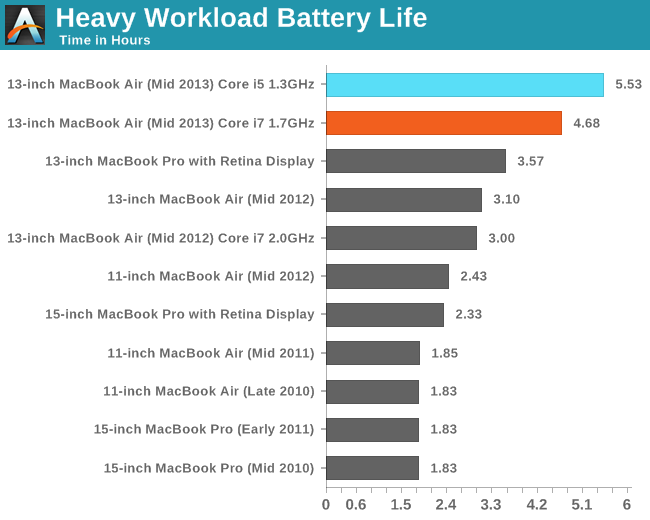The 2013 MacBook Air: Core i5-4250U vs. Core i7-4650U
by Anand Lal Shimpi on July 4, 2013 8:00 AM ESTBattery Life
I ran the i7-4650U based 13-inch MBA through the same suite of battery life tests as the un-upgraded base model. What's important to note about all of these tests is that the amount of work done per cycle of the test doesn't vary based on performance. There's enough idle time baked in to make sure that the Core i7 based 13-inch MBA isn't artifically penalized by having to do more work than the i5 model simply because it's faster. The other thing I noticed while testing these two machines is that although both were equipped with the exact same Samsung panel, their brightness curves were slightly different. At the same brightness setting under OS X (or Windows 8), both panels responded differently. Both were capable of similar max brightness values but it's clear that either Apple is doing some calibration here that's panel lot specific or there's a significant variance in how these panel/backlight/electronics combinations respond (or both).
I reproduced the battery life test details below:
The light and medium suites are inherently related - they use the same workload and simply vary the aggressiveness of that workload. The light test hits four different websites every minute, pausing for nearly the entire time to simulate reading time. Flash is enabled and present on three of the sites. The long pause time between page loads is what really makes this a light test. Web browsing may be the medium for the test but if all you’re doing is typing, watching Twitter update and maybe lazily doing some other content consumption this is a good representation of the battery life you’ll see. It’s a great way of estimating battery life if you’re going to be using your notebook as a glorified typewriter (likely a conservative estimate for that usage model).
The medium test hits the same webpages (Flash and all) but far more aggressively. Here there’s less than 10 seconds of reading time before going onto the next page. It sounds like a small change but the impact on battery life is tremendous.
Both the light and medium tests are run in their default state with processor graphics enabled, as well as with the discrete GPU forced on. I run with the dGPU on as well because it’s far too often that a single application open in the background will fire up the dGPU and contribute to draining your battery. The goal here is to deliver useful numbers after all.
The final test is very similar to our old heavy multitasking battery life tests, but with some updates. Here I’m downloading large files at a constant 1MB/s from a dedicated server, while playing back a looped 1080p H.264 movie (the Skyfall trailer) all while running the medium battery life test. The end result is a workload that gives you a good idea of what a heavy multitasking usage model will do in terms of battery life. I’ve found that OS X tends to fire up the dGPU anyway while running this workload so I saw no reason to run a separate set of numbers for processor and discrete graphics.

In our mostly idle workload, there's virtually no difference between the two parts in terms of battery life. The i7-4650U is actually able to boast a slightly higher number here but for all intents and purposes the two are equal. Apple's 12 hour estimate comes from a slightly lighter workload than what we run, so I see no reason that Apple couldn't claim equivalent max battery life regardless of what CPU option you pick.

Under load we begin to see the expected: the Core i7 upgrade does have a power cost associated with it. There's around a 13% reduction in battery life here compared to the standard 13-inch MBA configuration. Heavier workloads tend to force the CPU cores into higher frequency (and thus higher voltage) states. In the case of the i7 both the frequency and voltages are higher, which drives power consumption higher than the i5 resulting in lower battery life.

The gap between the i5 and i7 grows to its largest point in our heaviest workload, which makes sense. Here there's around an 18% reduction, or almost a full hour of battery life (52 minutes). If you ran both processors at full tilt nonstop (think looped Cinebench until both batteries die) you'd probably see an even larger gap. In this case I think the differences here are pretty reasonable expectations for most target usage models of the MacBook Air.
Thermals
As the MacBook Air isn't a handheld tablet, the limit for what's an acceptable max skin temperature is much higher. Just as there's an impact on battery life with the Core i7, there's also an impact on thermals. I ran a CPU and GPU intensive workload and measured thermals at three different points on the system: max temperature on the keyboard side of the system (upper left corner of the keyboard), max temperature on the bottom of the machine as well as the max temp reported by the CPU core proximity thermistor.
| 13-inch MacBook Air (Mid 2013) CPU Comparison - Observed Temperatures | ||||
| Location | Keyboard/Top | Bottom (sustained) | Bottom (max) | Internal CPU Proximity Thermistor |
| Intel Core i5-4250U | 47.1 °C | 41.4 °C | 41.4 °C | 92.2 °C |
| Intel Core i7-4650U | 47.7 °C | 42.1 °C | 46.6 °C | 96.7 °C |
Average temperatures aren't substantially higher on the i7, however you will notice that there's a column for max observed temperature on the bottom of the chassis where the upgraded MacBook Air does show a considerably higher temperature. The higher temp isn't sustained but I did record occasional blips up to 46.6 °C on the bottom of the chassis while the i5 model pretty much topped out at its sustained temperature. Internal temps are obviously much higher as well.
The impact on acoustics wasn't really noticeable. Under extended load both systems hit the same 6500 RPM fan speed, which given the same cooling system produced identical acoustic profiles. I tried to see if the i7 would ramp to 6500 RPM any quicker than the i5 but in most cases I don't believe it did, at least appreciably so.










127 Comments
View All Comments
FwFred - Thursday, July 4, 2013 - link
Probably the benefits matter much more in non-optimal cases. I think Anand's experience mirrors my own. One bad browser tab can kill the battery life due to javascript or flash. If Mavericks is able to prevent this somehow (not really sure how it could do it within Chrome between tabs, but maybe Safari), I would be very pleased.solmaker - Thursday, July 4, 2013 - link
Thanks for the sage observations, K-Knight. If you're right that Mavericks moves heavier workloads down toward the "light" category, that would tend to decrease the i5 vs i7 battery difference, since they're very close when "light". But I'd think even the "light" case would be helped by Timer Coalescing (batching periodic timer wake-ups) and AppNap (by nailing unused background tasks). My fantasizing about 12 hour MBA 11" battery life was based on anecdotal forum reports of 13+ hour 11" life using the Mavericks beta, but that hasn't been verified. My own usage often has an idle VMware Fusion WinXP session in the background, so I'd get great benefits if AppNap could zap that.KitsuneKnight - Friday, July 5, 2013 - link
Thinking about it more, the light load would also receive some benefit as well. Before when I wrote 'light', I was more so thinking about a system with no apps running, effectively just sitting idle... which is obviously not a 'light' workload, but a no-workload. Although with the current low energy usage of OS X the gains might not be massive (maybe even within the margin of error).I still think the best cases will be with poorly programmed apps with lots of useless timers keeping the system awake, which Timer Coalescing will help a bit with when the app is in the foreground, and AppNap much more so when it's in the background.
I'm not sure how Fusion is architectured, but I /think/ how it works (based on how Workstation was many years ago... on Windows) it won't automagically be able to benefit from AppNap, and VMware will have to put a bit of effort into making it opt into AppNap when appropriate. Parallels Desktop already has a feature where (under the right circumstances), idle VMs will be paused, although it's not as aggressive as it could be.
It'll be interesting to see how developers make their apps work with AppNap (most won't have to do anything beyond linking against the 10.9 frameworks). I imagine at the start many developers will just try to disable AppNap for their app and write blog posts about how 'it's so pointless and doesn't everyone just leave their computer plugged in', before everyone starts embracing it... but maybe I'm jaded from how new technologies get adopted in Windows / Linux land.
solmaker - Saturday, July 6, 2013 - link
Thanks again, K-K. I wonder whether AppNap with be "Opt In" or "Opt Out"? If the latter, then VMware Fusion may automagically AppNap when hidden.fokka - Thursday, July 4, 2013 - link
thanks for the comparison, anand! these are exactly the questions i'm wondering about when researching for a mobile pc: is there a benefit in battery life when chosing a low end cpu, or is the faster cpu just quicker and can even save power with longer idling times?for me it would be clear to chose the i7 here, since it would be be my main computer and battery is similar to the i5 in scenarios most likely with my usage: light workload. but then, if i decide to load up lightroom or want to play a quick game, i can rest assured that i'm eeking out quite a couple percent more performance than on the stock cpu.
now the only thing i'm waiting for is a proper zenbook-refresh :)
ananduser - Thursday, July 4, 2013 - link
I feel you Anand; too bad that other companies don't offer such "one size fits all" lineups like Apple. The exaggerate range of choices from other companies simply adds confusion.I like the detail and effort that went into reviewing different SKUs of the same unit. Hope you do the same for some upcoming items from Lenovo, Asus, Samsung, Sony etc.
Since I mentioned Sony, I want to ask you if there is a chance you could get your hands on the new Vaio Pro and Vaio Duo that sport that "fancy" triluminous display. None of the reviews available has actually gone the length to see what's with that new "quantum dot" tech. Only Anandtech™ can shed light here. What ? Sony hardly sends you Vaios for review ? I dunno, ask them harder ?
Awful - Thursday, July 4, 2013 - link
Thanks Anand, very useful!Any chance of including some GPU/Gaming comparisons too? It would be interesting to see the results of the increased thermal constraints of the i7 on GPU perf (could even be worse I imagine under certain loads?)
ciparis - Thursday, July 4, 2013 - link
If Firefox really takes 17-37 minutes to build, all I can say is wow, what a %$#@! pig.Mackan - Friday, July 5, 2013 - link
Can you also do a battery life test in Windows, via Boot Camp, using pure EFI install which seems to be supported now.US Fiscal Situation - Friday, July 5, 2013 - link
Yeah.. no one else can make thinner and lighter laptops, erm... except for the firms that can and do...Take the Vaio Pro 11, it weighs less (870g), it's thinner and yet has the same battery life.
The Vaio manages to cram in a much higher resolution (full HD) TOUCHSCREEN, NFC and SD card reader. It even has Ethernet support built into the power supply which creates a WIFI hotspot
Both machines are comparable performance/processor wise but one costs £60 less (i7,4GB RAM, 256GB SSD)- No prizes for guessing which.
BTW apropos business use- it should be noted that the lack of boot camp drivers for W8 means that you can't run all of the programs that you might need.
US Fiscal Situation http://bit.ly/16SsEFt